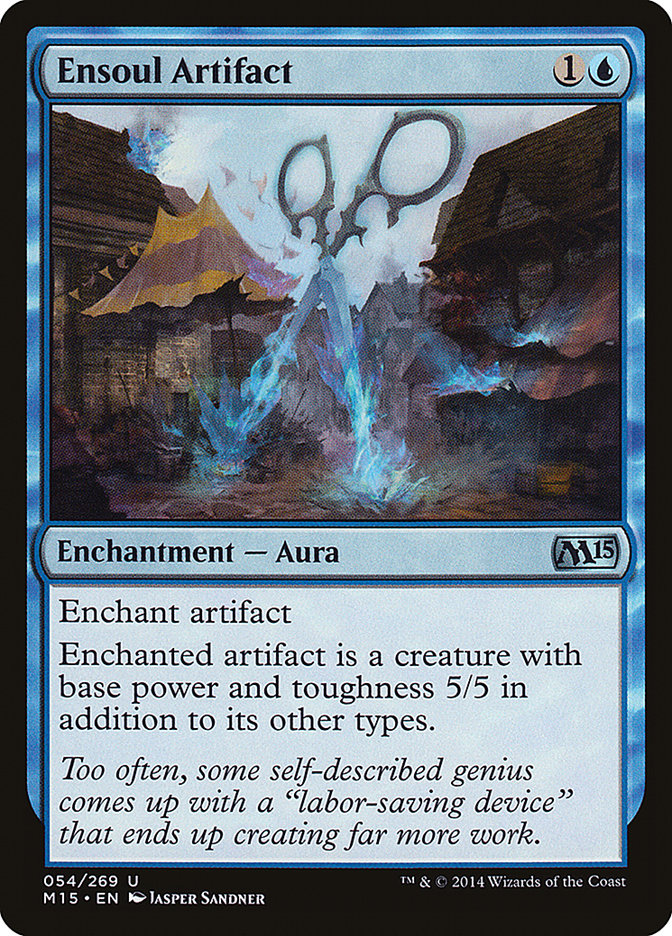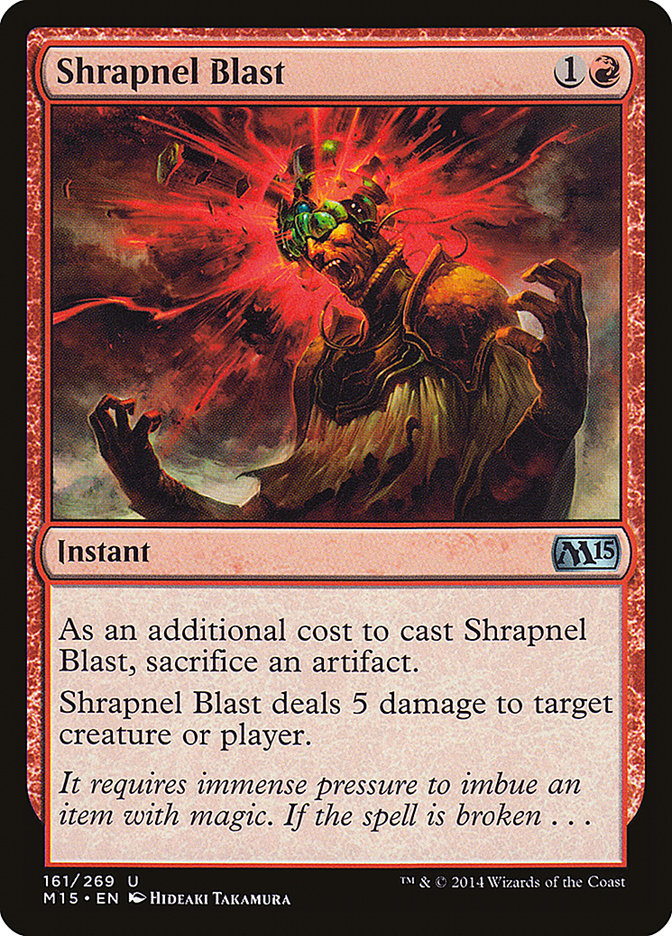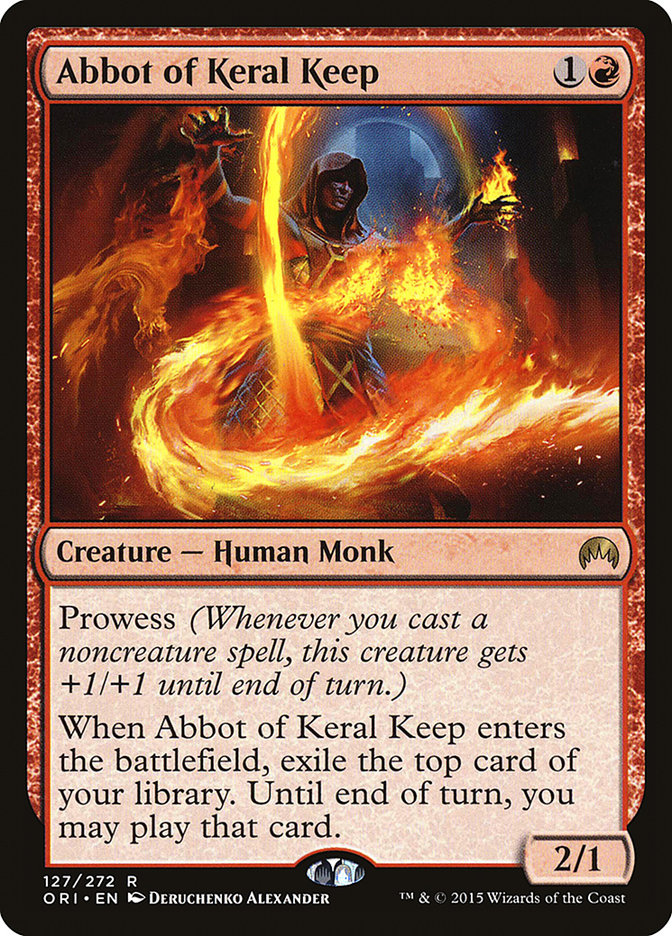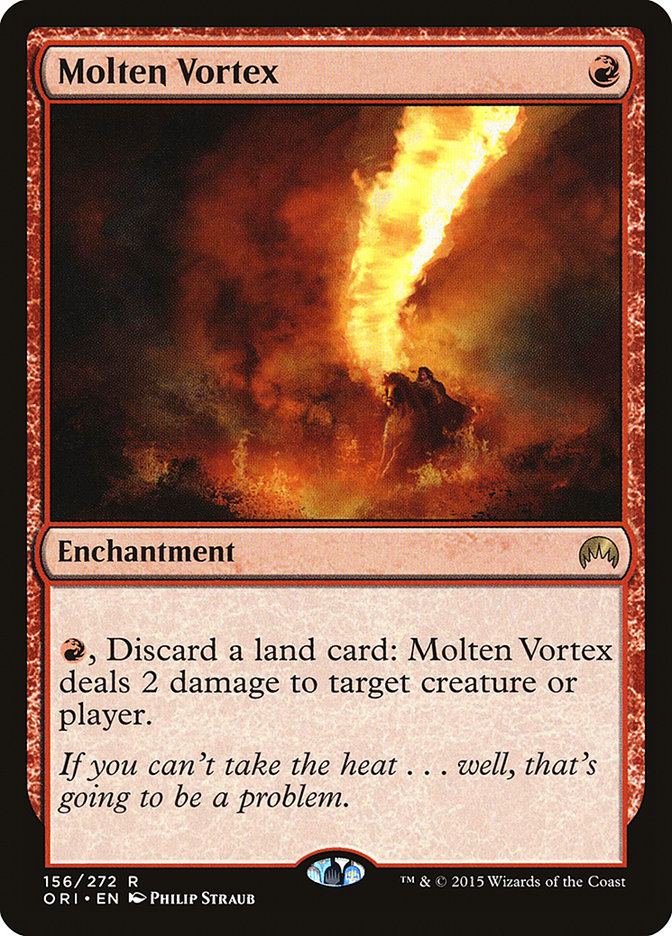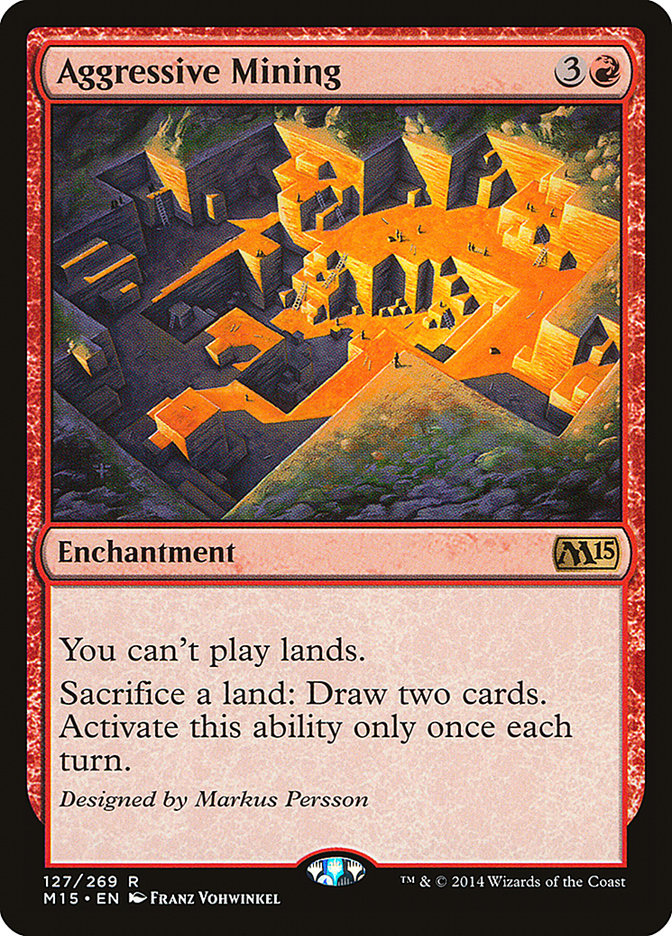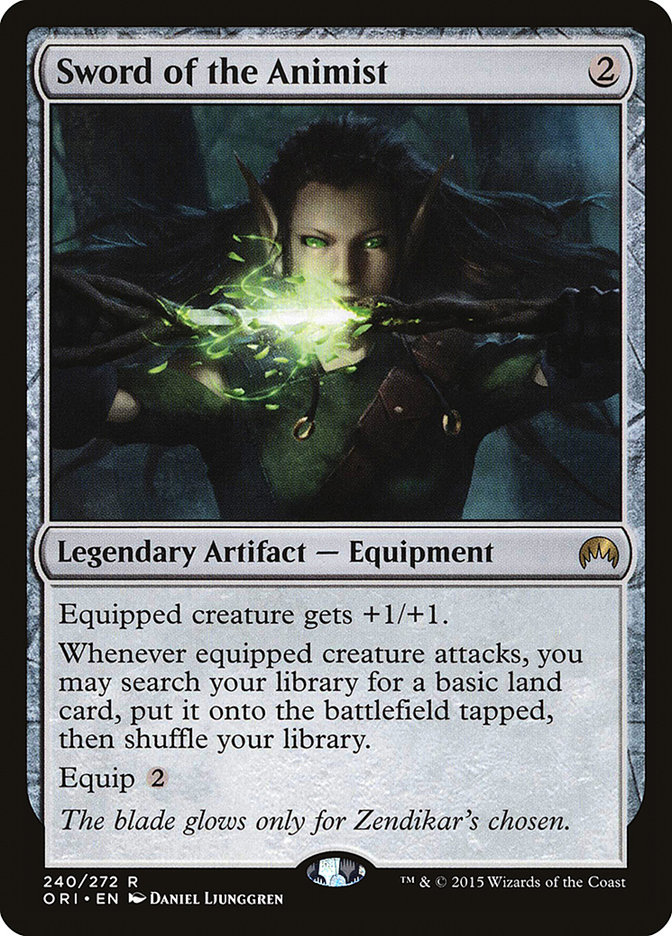We finally did it.
After sitting in the tier-two and tier-Three range of decks, eight copies of each spell broke into the Top Eight of the biggest tournament of the season. I guess Magic Origins gave the format enough artifact cards to make the difference, and here we are. The moment I saw Mike Sigrist on U/R Thopters, I couldn’t stop watching the Pro Tour action this weekend, and then I saw to my amazement that more and more people were piloting the deck. They really were on to something; dozens of competitors made Day Two having arrived at similar conclusions.
There were brews all over the place, really. G/B Demonic Pact, with Woodland Bellower into Invasive Species to bounce the Pact? Innovations to Jeskai Ascendancy Combo? Andrew Cuneo’s U/R Tutelage mill deck? Sign me up for the next Pro Tour! Cedric, can you do that? He can probably do that, thanks, buddy.
Pro Tours, especially this one, show us two things: Pros really know how to build and test good decks, and they know how to build and test good decks that are good at beating other people’s good decks. Pro Tours are all about knowing the metagame, and what might otherwise be an excellent deck at an FNM or even an Open Series event might be the wrong choice for the big show. Decks like U/B Control, Abzan Aggro, and Jeskai Tokens, for example, seemed to miss out on the bounty.
Mono-Red, however, is almost always a safe choice.
Joel Larsson’s Mono-Red list ended up on top, and it looks super clean at first glance. Searing Blood in the maindeck as well as Wild Slash give you some idea of what he expected in the metagame – the mirror, it seems. My favorite card in the list is one I’d been playing myself since the Prerelease.
This weekend, Mike Flores famously compared it to Snapcaster Mage, and he’s not wrong – this is a 2/1 for two with upside (Snapcaster Mage having flash as its upside instead of Prowess), and they both generate you a card. I wouldn’t be surprised if you see the Abbot creeping into more and more other decks for its effect. The Snapcaster Mage comparison is obviously a stretch, but I’d venture to say he’s the red Den Protector. Early on he’s a 2/1 (and I saw a lot of Den Protectors as Goblin Pikers this weekend), but later on he’ll guarantee you an extra card. The Prowess is a bonus, really… it’s pretty good as just “chump blocker, draw a card.” Maybe Jeskai Heroic, with him being a “heroic” target himself? Hmmm…
But I’ve already talked about the Abbot. One other Mono-Red card I saw that did some great work on day one that’s only seen marginal discussion since its release caught my eye for the card to feature today: Molten Vortex.
The obvious comparison is Seismic Assault, last printed seven years ago in Tenth Edition. This variant of Seismic Assault is not combo-friendly; any activated ability that costs mana is generally not a great combo piece. Although Johnny, Combo Player wasn’t as excited with this particular enchantment, it has lots of fair applications, too. In every Mono-Red deck, it makes every draw count. Mono-Red players know that every Mountain you draw later in the game is a dud. If you had a one-lander, you probably mulliganed, so you rarely want to draw any Mountains that aren’t in your opening hand. Molten Vortex, then, gives you a 100% hit rate on your draw step. Creature? Great! Burn spell? Great! Mountain? Burn spell!
It’s not hard to shoehorn Molten Vortex into any burn deck, but there’s got to be a way to make it your primary road to victory. To do this, we need to draw lots of cards, which means putting them in my hand, not exiling them with something like Abbot of Keral Keep or Outpost Siege.
Got it!
If I’m discarding lands, I probably don’t need them on the battlefield. Thus, why not toss all my lands under the proverbial bus for, strangely enough, more lands? You can keep the engine going turn after turn, drawing other burn spells and your Shock Mountains. Sounds like fun, right?
Spells (29)
- 4 Searing Blood
- 3 Aggressive Mining
- 1 Hordeling Outburst
- 4 Tormenting Voice
- 4 Wild Slash
- 1 Fiery Impulse
- 1 Alhammarret's Archive
- 4 Exquisite Firecraft
- 3 Molten Vortex
- 3 Pyromancer's Goggles
- 1 Magmatic Insight
Sideboard

Let’s break it down real quick.
In the creature category, well, there’s not much. Generator Servant has gotten a lot of mileage in decks I’ve played over the last year, and although the haste it provides is less relevant with such a small creature count, the mana side is relevant. Once you’re locked out of playing lands, Generator Servant can fulfill the colorless cost requirement of your spells, giving you a bit more reach when you’ve sacrificed down to just two or three Mountains. It can also ramp you into your powerful artifacts, discussed below. Avaricious Dragon is a dangerous proposition, but here I think you can get paid off pretty well. It’s a big beater that you just want to make sure you don’t play into open mana… that end-step trigger will get you even if they kill your Dragon in response.
The spells are fairly standard. Many of them are shared pound-for-pound with Joel Larsson’s winning list, namely the full sets of Wild Slash, Searing Blood, and Exquisite Firecraft. Even the one-of Fiery Impulse matches Larrson’s deck. Tormenting Voice lets you discard extra copies of Aggressive Mining or Molten Vortex, as neither is relevant in multiples. Hordeling Outburst is a fine spell for early blocks, and unlike something that might fit here – say, Anger of the Gods – Hordeling Outburst can actually defeat your opponent. Magmatic Insight seems counterproductive, but in a deck whose land count is so artificially inflated and which is so reliant upon assembling a specific two-card combo (we don’t do much when Aggressive Mining doesn’t have a Molten Vortex beside it), you may need to trade in a land to dig for more of your relevant spells.
The two enchantments are known, but Pyromancer’s Goggles and Alhammarret’s Archive are game-changing artifacts that, in this deck, function quite similarly. The Goggles provide mana while copying things like Tormenting Voice to draw four cards, trades your Fiery Impulse for a six-toughness creature, or allows a Searing Blood to kill a Courser of Kruphix and hit them for six. Alhammarret’s Archive’s life-gaining clause is no help to us here, but it can go alongside Pyromancer’s Goggles to make either a Magmatic Visions or a Tormented Voice draw you eight cards. Every Aggressive Mining activation draws you four, and Avaricious Dragon draws you two extra cards a turn instead of one. It might be too cute, but I love cute.
There are twenty-six Mountains, which sounds like a lot, but you’ll be discarding many of them to your filter spells and Molten Vortex. In the meantime, they’ll power the rest of your spells. In short, flooding is much less problematic in this deck.
The sideboard is a bit of a crapshoot, but it features some of Standard’s best cards; Anger of the Gods comes in against any mono-colored aggro decks. Roast proved to be an excellent choice this weekend, and any match against a deck that’s not like you will want this over any number of Wild Slashes or Searing Bloods. Thunderbreak Regent is a great transformative choice – after seeing only a couple of creatures in the maindeck, most control or midrange opponents will side out their creature removal. For the situational spells they leave in, Regent’s trigger punishes them properly. I prefer it over Eidolon of the Great Revel here, which would kill me as quickly as it kills them. Three more copies of Hordeling Outburst round out the sideboard when you need to buy time against the eight-power green bruisers you’ll face down and never ever be able to kill.
This version pushes the top end, leveraging powerful effects and overwhelming your opponent with card advantage and top-notch burn. That being said, I think you can bring this thing closer to the ground as a finisher for an aggressive deck. To help us with that and to keep on-theme, Magic Origins brought another tool to this strategy.
So most people have decried this artifact as not worth the paper it was printed on, and I agree – for the moment. Until we wait to see the return to landfall or something like it, though, I think it might find a home here. See, when the Sword of the Animist triggers, you can search a land out of your deck and put it directly onto the battlefield, sidestepping Aggressive Mining’s restriction. Paired together with a combat-ready creature, that allows Sword of the Animist’s trigger to provide you either a free land drop or two free cards. That sounds fun!
Creatures (17)
- 3 Firedrinker Satyr
- 4 Monastery Swiftspear
- 4 Lightning Berserker
- 3 Zurgo Bellstriker
- 3 Chandra, Fire of Kaladesh
Lands (24)
- 24 Mountain
Spells (19)

The creature base is the exact same as Joel’s, replacing only the four Abbots with three copies of Chandra, Fire of Kaladesh. All the one-drops are Sword-ready and many can enter the battlefield, grab the Sword and get in the Red Zone immediately. Lightning Berserker works especially well in a deck that has a tendency to flood.
Lightning Strike is a little more inclusive than the burn spells found in the first deck, hitting something for three no matter what. The rest of the cards reappear from the first list with the exception of Break Through The Line. Because the gameplan is different here, Break Through The Line is a critical piece in defeating your opponent. It lets you swing with a Sword-wielding one-drop without fear of blocking, and right away besides. It lets you sneak a Lightning Berserker through then pump for a lot to win the game. Every creature can be targeted by Break, and Chandra can also gain haste to attack and/or tap the turn you play her, potentially transforming immediately.
At the end of the day, both decks use a similar engine to answer one of red’s biggest problems in Standard: how do I win the game when the opponent’s at more than four life and I’m in topdeck mode?
Aggressive Mining, a card I’ve been wanting to use since its printing, seems to pair really well with Molten Vortex, a card that’s not scary when you play it but which gets scarier the longer the game goes. That’s not too bad for a one-mana enchantment. The sky’s the limit with the Vortex; maybe a Mono-Green deck with ways to cheat lands into your hand or onto the battlefield is a good strategy. Nissa’s Pilgrimage, Atarka’s Command, and Seek the Horizon come to mind. Maybe blue is a better strategy, with cards like Master the Way and Treasure Cruise keeping your hand a healthy size, brimming with lands waiting to be discarded.
What’s your take on the Vortex? Has it taken up residence in your mono-red sideboard to provide some late-game reach, or have you explored the synergy potential that makes the Vortex such a nifty card?


